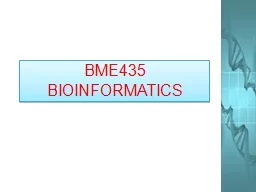

Section 1 Introduction and biological databases Section 2 Sequence alignment Section 3 Gene and promoter prediction Section 4 Molecular phylogenetics Section 5 Structural Bioinformatics ID: 912620
Download Presentation The PPT/PDF document "BME435 BIOINFORMATICS BIOINFORMATICS" is the property of its rightful owner. Permission is granted to download and print the materials on this web site for personal, non-commercial use only, and to display it on your personal computer provided you do not modify the materials and that you retain all copyright notices contained in the materials. By downloading content from our website, you accept the terms of this agreement.
Slide1
BME435BIOINFORMATICS
Slide2BIOINFORMATICS
Section 1: Introduction and biological databases.Section 2: Sequence alignment.Section 3: Gene and promoter prediction.
Section 4: Molecular phylogenetics.
Section 5: Structural Bioinformatics
Section 6: Genomics and Proteomics
Slide3Section 1: Introduction and biological databases
1- Introduction
What is BIOINFORMATICS?
Goal/Scope
Applications
Limitations New Themes
Slide4WHAT IS BIOINFORMATICS?
Bioinformatics is an interdisciplinary reseach area at the interface between computer science and biological science.
Increasingly popular field - There is a very
high demand for
bioinformaticians both in
industry and in academia.
Slide5BIOINFORMATICS involves the technology that uses computers forStorage,Retrieval,
Manipulation,Distribution of information related to biological macromolecules such as DNA, RNA, and proteins.
Slide6HOW BIOINFORMATICS DIFFERS FROM A RELATED FIELD KNOWN AS COMPUTATIONAL BIOLOGY?
BIOINFORMATICS is limited toSequence,
Structural and functional analysis od genes and genomes and their corresponding products.
COMPUTATIONAL BIOLOGY encompasses all biological areas that involve computation.
E.g. Mathematical modelling of ecosystems
Population dynamics,
Application of Game theory in behavioral studies.
Slide7GOALS and SCOPE
GOALS: Better understand the living cell
How it functions at the molecular level.
Solving functional problems using sequence and sometimes structural approaches has proved to be a fruitful endeavor.
Slide8SCOPE:Bioinformatics consists of two subfields:
The development of computational tools and databases.The application of these tools and databases in generating biological knowledge to beter understand living systems.
Slide9Overview of various subfields of bioinformatics
The applications of the tools fall into three areas:
Sequence analysis,
Structure analysis,
Function analysis.
Slide10APPLICATIONS
Structure Analysis
Sequence Analysis
Function Analysis
Nucleic acid structure
prediction
Protein structure
prediction
Protein structure
Classification
Protein structure
comparison
Genome comparison
Phylogeny
Gene & promoter
prediction
Motif discovery
Sequence database
Searching
Sequence alignment
Metabolic pathway
modelling
Gene expression
profiling
Protein interaction
prediction
Protein subcellular
localization
prediction
SOFTWARE DEVELOPMENT DATABASE CONSTRUCTION AND CURATION
Slide11APPLICATIONSBIOINFORMATICS having a major impact on many areas of biotechnology and biomedical sciences.
e.g.Knowledge-based drug design,
Forensic DNA analysis,
Agricultural biotechnology.
Slide12LIMITATIONS
Bioinformatics has a number of inherent limitations.
Bioinformatics is by no means a mature field.
Most algorithms lack the capability and sophistication to truley reflect the reality.
Errors in sequence alignment, an affect the outcome of structural or phyligenetic analysis.
Many accurate but exhausitive algorithms cannot be used because of the slow rate computation. Instead, less accurate but faster algorithms have to be used.
IT IS A GOOD PRACTICE TO USE MULTIPLE PROGRAMS, IF THEY ARE AVAILABLE, AND PERFORM MULTIPLE EVALUATIONS.
A MORE ACCURATE PREDICTION CAN OFTEN BE OBTAINED IF ONE DRAWS A CONSENSUS BY COMPARING RESULTS FROM DIFFERENT ALGORITHMS.
Slide13NEW THEMES
There is no doubt that bioinformatics is a field that holds great potential for revolitionizing biological research in the coming decades.
The field is undergoing major expansion. In addition to providing more reliable and more rigorous computational tools for sequence, structural and functional analysis.
THE MAJOR CHALLENGE FOR FUTURE BIOINFORMATICS DEVELOPMENT IS
TO DEVELOP TOOLS FOR ELUCIDATION OF THE FUNCTIONS AND INTERACTIONS OF ALL GENE PRODUCTS IN A CELL.